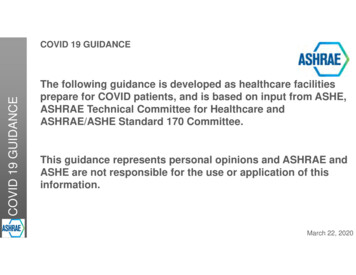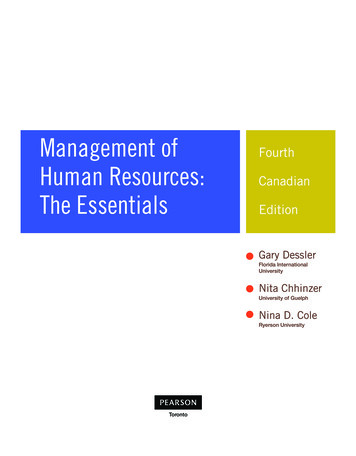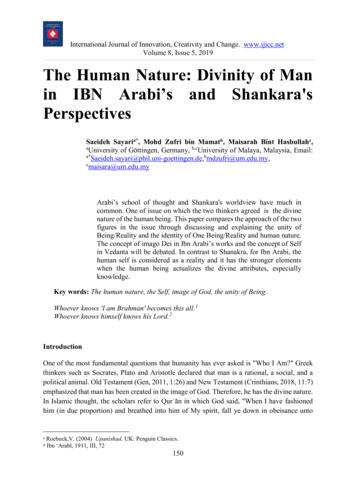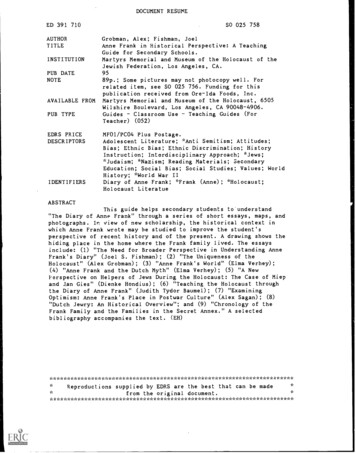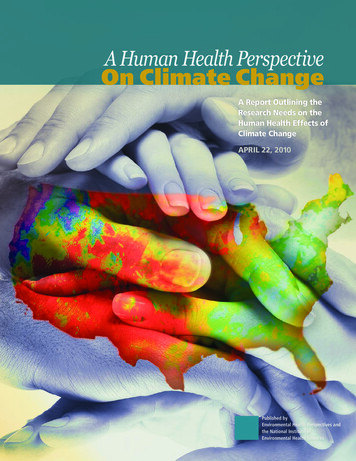
Transcription
A Human Health PerspectiveOn Climate ChangeA Report Outlining theResearch Needs on theHuman Health Effects ofClimate ChangeAPRIL 22, 2010Published byEnvironmental Health Perspectives andthe National Institute ofEnvironmental Health Sciences1
A Human Health PerspectiveOn Climate ChangeA Report Outlining the Research Needson the Human Health Effects ofClimate ChangeThe Interagency Working Group on Climate Change and Health1APRIL 2010Published by Environmental Health Perspectives andthe National Institute of Environmental Health SciencesEnvironmental Health Perspectives (ISSN 0091-6765) is a publication of the Public Health Service, U.S. Department of Health and Human Services. EHP is an open-access monthly journal of peer-reviewedresearch and news on the impact of the environment on human health. EHP also publishes a quarterly Chinese Edition (ISSN 1542-6351) and occasional special issues. The Secretary of Health and Human Serviceshas deemed EHP to be necessary in the transaction of the public business required by law of this department. EHP was not involved in the peer review of this report.CorrespondenCe: Send all correspondence to Dr. Christopher J. Portier, Senior Advisor to the Director, Principle Investigator, Environmental Systems Biology, PO Box 12233, MD B2-08, National Institute ofEnvironmental Health Sciences, Research Triangle Park, NC 27709 USA, E-mail: portier@niehs.nih.gov, Telephone: 919-541-3484, Fax: 919-541-1994.Copyright And reproduCtion: A Human Health Perspective On Climate Change: A Report Outlining the Research Needs on the Human Health Effects of Climate Change is a publication of theU.S. government. Publication of this report lies in the public domain and is therefore without copyright. Some photographs or figures contained in this report are copyrighted by commercial organizations orindividuals that may not be used without obtaining prior approval from the holder of the copyright.disClAimer: The publication of this document does not mean that the National Institute of Environmental Health Sciences (NIEHS) condones, endorses, approves, or recommends the use of any products,services, materials, methodology, or policies stated therein. Conclusions and opinions are those of the individual authors and do not reflect the policies or views of the NIEHS.disCriminAtion prohibited: Under the provisions of applicable public laws enacted by Congress since 1964, no person in the United States shall, on the grounds of race, color, national origin,handicap, or age, be excluded from participation in, be denied the benefits of, or be subjected to discrimination under any program or activity (or, on the basis of sex, with respect to any educational programor activity) receiving Federal financial assistance. In addition, Executive Order 11141 prohibits discrimination on the basis of age by contractors and subcontractors in the performance of Federal contracts,and Executive Order 11246 states that no federally funded contractor may discriminate against any employee or applicant for employment because of race, color, religion, sex, or national origin. Therefore,the NIEHS must be operated in compliance with these laws and executive orders.suggested CitAtion: Portier CJ, Thigpen Tart K, Carter SR, Dilworth CH, Grambsch AE, Gohlke J, Hess J, Howard SN, Luber G, Lutz JT, Maslak T, Prudent N, Radtke M, Rosenthal JP, Rowles T, Sandifer PA,Scheraga J, Schramm PJ, Strickman D, Trtanj JM, Whung P-Y. 2010. A Human Health Perspective On Climate Change: A Report Outlining the Research Needs on the Human Health Effects of ClimateChange. Research Triangle Park, NC:Environmental Health Perspectives/National Institute of Environmental Health Sciences. doi:10.1289/ehp.1002272 Available: www.niehs.nih.gov/climatereport.1Disclaimer: The interagency Working Group on climate change and Health (iWGccH) is an ad hoc group formed by participating federal agencies and organizations atthe invitation of the National institute of environmental Health sciences (NieHs), National Oceanic and atmospheric administration (NOaa), centers for Disease control andPrevention (cDc), and environmental Protection agency (ePa) following the January 2009 “Workshop on a research agenda for managing the Health risks of climate change,”sponsored by the institute of medicine roundtable on environmental Health sciences, research, and medicine. This report identifies gaps in knowledge of the consequences forhuman health of climate change, and suggests research to address them. The content, views, and perspectives presented in this report are solely those of the authors, and do notreflect the official views, policies, or implied endorsement of any of the individual participating federal agencies or organizations.i
Table ofContentsiiiWorking GroupivExecutive Summary2Introduction9Crosscutting Issues for Climate Change and Health89910iiSusceptible, Vulnerable, and Displaced PopulationsPublic Health and Health Care InfrastructureCapacities and Skills NeededCommunication and Education13Asthma, Respiratory Allergies, and Airway Diseases17Cancer21Cardiovascular Disease and Stroke25Foodborne Diseases and Nutrition29Heat-Related Morbidity and Mortality33Human Developmental Effects37Mental Health and Stress-Related Disorders41Neurological Diseases and Disorders45Vectorborne and Zoonotic Diseases51Waterborne Diseases57Weather-Related Morbidity and Mortality60Synthesis and Recommendations64Summary Statementwww.niehs.nih.gov/climatereport
A Human Health Perspect ive ON CLIMATE CHANGEThe Interagency Working Group onClimate Change and HealthChristopher J. Portier, PhD(COOrdINATING LEAd AuTHOr)National Institute of Environmental Health SciencesKimberly Thigpen Tart, JD(COOrdINATING EdITOr)National Institute of Environmental Health SciencesSarah R. Carter, PhDAAAS Fellow, U.S. Environmental Protection AgencyCaroline H. Dilworth, PhDNational Institute of Environmental Health SciencesAnne E. GrambschU.S. Environmental Protection AgencyJulia Gohlke, PhDNational Institute of Environmental Health SciencesJeremy Hess, MD, MPH(LEAd AuTHOr)Centers for Disease Control and PreventionSandra N. HowardDepartment of Health and Human ServicesGeorge Luber, PhD(LEAd AuTHOr)Centers for Disease Control and PreventionJeffrey T. Lutz, PhDNational Oceanic and Atmospheric AdministrationTanya Maslak, MPH(LEAd AuTHOr)U.S. Global Change Research Program,University Corporation for Atmospheric ResearchParticipating AgenciesIn addition to the working group, many scientists and stafffrom the following agencies contributed to the developmentand review of this white paper. Staff of the u.S. Global Changeresearch Program provided logistical and technical support,but did not conduct a formal review.Centers for Disease Control and Prevention National Center for Environmental HealthNational Institutes of Health National Institute of Environmental Health Sciences Fogarty International Center Trans-NIH Working Group on Climate Change and HealthNational Oceanic and Atmospheric AdministrationOffice of the Secretary, Department of Health andHuman ServicesU.S. Environmental Protection AgencyU.S. Department of AgricultureU.S. Department of StateNatasha Prudent, MPHCenters for Disease Control and PreventionMeghan Radtke, PhD(LEAd AuTHOr)AAAS Fellow, U.S. Environmental Protection AgencyJoshua P. Rosenthal, PhDFogarty International CenterTeri Rowles, DVM, PhDNational Oceanic and Atmospheric AdministrationPaul A. Sandifer, PhDNational Oceanic and Atmospheric AdministrationJoel Scheraga, PhDU.S. Environmental Protection AgencyPaul J. Schramm, MS, MPHCenters for Disease Control and PreventionDaniel Strickman, PhD(LEAd AuTHOr)U.S. Department of Agriculture, Agricultural Research ServiceJuli M. Trtanj, MES(LEAd AuTHOr)National Oceanic and Atmospheric AdministrationPai-Yei Whung, PhDU.S. Environmental Protection Agencywww.niehs.nih.gov/climatereportiii
A Human Health Perspect ive ON CLIMATE CHANGEExecutiveSummaryThe purpose of this paperis to identify research needsfor all aspects of theresearch-to-decision makingClimate change endangers human health,affecting all sectors of society, both domesticallyand globally. The environmental consequencesof climate change, both those already observed and thosethat are anticipated, such as sea-level rise, changes inprecipitation resulting in flooding and drought, heatwaves, more intense hurricanes and storms, and degradedpathway that will help usair quality, will affect human health both directly andunderstand and mitigate thehuman health is especially challenging because both theindirectly. Addressing the effects of climate change onsurrounding environment and the decisions that peoplehealth effects of climate change,as well as ensure that wechoose the healthiest andmake influence health. For example, increases in thefrequency and severity of regional heat waves—likelyoutcomes of climate change—have the potential to harm alot of people. Certain adverse health effects can probablybe avoided if decisions made prior to the heat waves resultmost efficient approaches toin such things as identification of vulnerable populationsclimate change adaptation.preventive measures such as air conditioning. This is asuch as children and the elderly and ensured access tosimplified illustration; in real-life situations a host of otherfactors also come into play in determining vulnerabilityincluding biological susceptibility, socioeconomic status,cultural competence, and the built environment. In a worldof myriad “what if” scenarios surrounding climate change,it becomes very complicated to create wise health policiesfor the future because of the uncertainty of predictingenvironmental change and human decisions. The need forsound science on which to base such policies becomes morecritical than ever.ivwww.niehs.nih.gov/climatereport
A Human Health Perspect ive ON CLIMATE CHANGERecognizing the complexity of this issue, an ad hoc InteragencyWorking Group on Climate Change and Health (IWGCCH)2relationship to climate change, and identify the basic andapplied research needs of that category, as well as crosscuttingassembled to develop a white paper on relevant federal re issues where relevant. Most investigations of climate changesearch and science needs, including research on mitigation andand health have relied on environmental and ecological effectsadaptation strategies. Examples of mitigation and adaptationto extrapolate potential human health impacts; the IWGCCHresearch needs are identified, but a comprehensive discussiondeliberately chose to emphasize the need for research onof these issues is not included. These research and sciencehuman health outcomes over environmental impacts for thisneeds broadly include basic and applied science, technologicalreason: this approach highlights direct links between climateinnovations and capacities, public health infrastructure, andchange and federal research priorities that are often disease- orcommunication and education. Consideration is also given tooutcome-specific, and a focus on human health outcomesthe potential structure of a federal climate change and healthenables a holistic approach to exploring climate change-relatedresearch agenda and the use of scientific research results forhealth impacts. We recognize that the health consequencesapplications and decision making. The purpose of this paperidentified in this document are not exhaustive, and thatis to identify research critical for understanding the impact ofbecause so many climate change effects are prospective, someclimate change on human health so that we can both mitigateof the research needs enumerated may be speculative. Asand adapt to the environmental effects of climate change in themore information becomes available, new research needs mayhealthiest and most efficient ways. Although the group recog be identified and others rejected, but it is our intent that thisnizes the global nature of climate change’s impacts on humanreport may serve as a baseline discussion from which agencieshealth, the primary focus of this paper is on the situation in thecan proceed.United States.This report is organized around 11 broad human health3categories likely to be affected by climate change. Categoriesare arranged in alphabetical order, and no prioritization—forinstance as to likelihood of occurrence, severity of effects,or depth of current knowledge—is implied. Each categoryis broken into sections that introduce the topic, explain its.23cDc, HHs/Os, ePa, Nasa, NieHs, NiH/Fogarty, NOaa, DOs, UsDa, UsGcrPasthma, allergies, and airway diseases; cancer; cardiovascular disease and stroke; alterations in normal development;heat-related morbidity and mortality; mental health and stress disorders; neurological diseases and disorders;nutrition and food-borne illness; vector-borne and zoonotic disease; waterborne disease; weather-related morbidityand mortalitywww.niehs.nih.gov/climatereportv
A Human Health Perspect ive ON CLIMATE CHANGEExecutive SummaryHighlights:Asthma, Respiratory Allergies, and Airway Diseases—Respiratory allergies and diseases may become more prevalent becauseof increased human exposure to pollen (due to altered growing seasons),molds (from extreme or more frequent precipitation), air pollution andaerosolized marine toxins (due to increased temperature, coastal runoff,and humidity) and dust (from droughts). Mitigation and adaptation maysignificantly reduce these risks. Research should address the relationshipbetween climate change and the composition of air pollutant mixtures(e.g., how altered pollen counts and other effects of climate change affectthe severity of asthma) to produce models to identify populations at risk.Such tools support the use of science in understanding disease risks andas such, are an integral component of developing effective risk communi cation and targeting the messages to vulnerable populations.Cancer—Many potential direct effects of climate change on cancer risk,such as increased duration and intensity of ultraviolet (UV) radiation,are well understood; however the potential impact of changes in climateon exposure pathways for chemicals and toxins requires further study.Science should investigate the effects of mitigation and adaptationmeasures on cancer incidence so that the best strategies can be developedand implemented; for example, research to inform understanding ofthe benefits of alternative fuels, new battery and voltaic cells, and othertechnologies, as well as any potential adverse risks from exposure to theircomponents and wastes. Better understanding of climate change impactson the capacity of ocean and coastal systems to provide cancer curativeagents and other health-enhancing products is also needed.Cardiovascular Disease and Stroke— Climate change mayexacerbate existing cardiovascular disease by increasing heat stress,increasing the body burden of airborne particulates, and changing thedistribution of zoonotic vectors that cause infectious diseases linked withcardiovascular disease. Science that addresses the cardiovascular effectsof higher temperatures, heat waves, extreme weather, and changes in airquality on health is needed, and this new information should be appliedto development of health risk assessment models, early warning systems,health communication strategies targeting vulnerable populations, landuse decisions, and strategies to meet air quality goals related to climatechange. In some areas, cardiovascular and stroke risks resulting fromclimate change could be offset by reductions in air pollution due toclimate change mitigation.Foodborne Diseases and Nutrition— Climate change may beassociated with staple food shortages, malnutrition, and food contamina tion (of seafood from chemical contaminants, biotoxins, and pathogenicmicrobes, and of crops by pesticides). Science research needs in this areainclude better understanding of how changes in agriculture and fisheriesvimay affect food availability and nutrition, better monitoring fordisease-causing agents, and identification and mapping of complexfood webs and sentinel species that may be vulnerable to climatechange. This research could be used to prepare the public healthand health care sectors for new illnesses, changing surveillanceneeds, and increased incidence of disease, as well as development ofmore effective outreach to affected communities.Heat-Related Morbidity and Mortality—Heat-relatedillness and deaths are likely to increase in response to climatechange but aggressive public health interventions such as heat waveresponse plans and health alert warning systems can minimizemorbidity and mortality. Additional science should be focusedon developing and expanding these tools in different geographicregions, specifically by defining environmental risk factors,identifying vulnerable populations, and developing effective riskcommunication and prevention strategies.Human Developmental Effects—Two potential consequencesof climate change would affect normal human development:malnutrition—particularly during the prenatal period and earlychildhood as a result of decreased food supplies, and exposure totoxic contaminants and biotoxins—resulting from extreme weatherevents, increased pesticide use for food production, and increases inharmful algal blooms in recreational areas. Research should exam ine the relationship between human development and adaptationsto climate change, such as agriculture and fisheries changes thatmay affect food availability, increased pesticide use to control forexpanding disease vector ranges, and prevention of leaching fromtoxic waste sites into floodwaters during extreme weather events, sothat developmental consequences can be prevented.Mental Health and Stress-Related Disorders—By causing orcontributing to extreme weather events, climate change may resultin geographic displacement of populations, damage to property,loss of loved ones, and chronic stress, all of which can negativelyaffect mental health. Research needs include identifying keymental health effects and vulnerable populations, and developingmigration monitoring networks to help ensure the availability ofappropriate health care support.Neurological Diseases and Disorders— Climate change,as well as attempts to mitigate and adapt to it, may increase thenumber of neurological diseases and disorders in humans. Researchin this area should focus on identifying vulnerable populations andunderstanding the mechanisms and effects of human exposure towww.niehs.nih.gov/climatereport
A Human Health Perspect ive ON CLIMATE CHANGEExecutive Summaryneurological hazards such as biotoxins (from harmful algal blooms),metals (found in new battery technologies and compact fluorescentlights), and pesticides (used in response to changes in agriculture), aswell as the potentially exacerbating effects of malnutrition and stress.Vectorborne and Zoonotic Diseases—Disease risk may increaseas a result of climate change due to related expansions in vectorranges, shortening of pathogen incubation periods, and disruptionand relocation of large human populations. Research should enhancethe existing pathogen/vector control infrastructure including vectorand host identification; integrate human with terrestrial and aquaticanimal health surveillance systems; incorporate ecological studies toprovide better predictive models; and improve risk communicationand prevention strategies.Waterborne Diseases—Increases in water temperature, precipita tion frequency and severity, evaporation-transpiration rates, andchanges in coastal ecosystem health could increase the incidence ofwater contamination with harmful pathogens and chemicals, resultingin increased human exposure. Research should focus on understand ing where changes in water flow will occur, how water will interactwith sewage in surface and underground water supplies as well asdrinking water distribution systems, what food sources may becomecontaminated, and how to better predict and prevent human exposureto waterborne and ocean-related pathogens and biotoxins.Weather-Related Morbidity and Mortality—Increases in theincidence and intensity of extreme weather events such as hurricanes,floods, droughts, and wildfires may adversely affect people’s healthimmediately during the event or later following the event. Researchaimed at improving the capabilities of healthcare and emergencyservices to address disaster planning and management is neededto ensure that risks are understood and that optimal strategies areidentified, communicated, and implemented.In addition to the research needs identified in the individual researchcategories, there are crosscutting issues relevant to preventing oravoiding many of the potential health impacts of climate change in cluding identifying susceptible, vulnerable, and displaced populations;enhancing public health and health care infrastructure; developingcapacities and skills in modeling and prediction; and improving riskcommunication and public health education. Such research will leadto more effective early warning systems and greater public awarenessof an individual’s or community's health risk from climate change,which should translate into more successful mitigation and s. For example, health communications research is neededto properly implement health alert warning systems for extreme heatevents and air pollution that especially affects people with existingconditions such as cardiovascular disease. Such a risk communicationpilot project might demonstrate communication practices that areeffective in multiple areas, and contribute to a comprehensive strategyfor addressing multiple health risks simultaneously.Other tools are needed and should be applied across multiple categoriesto close the knowledge gaps, including predictive models to improveforecasting and prevention, evaluations of the vulnerability of healthcare and public health systems and infrastructure, and health impactassessments. Trans-disciplinary development would help to ensuretools such as improved baseline monitoring that will be more widelyapplicable, and thus more efficient and cost effective than thosecurrently available. In fact, many of the identified science needs willrequire trans-disciplinary responses. For example, to study how heatwaves alter ambient air pollution and the resulting combined impact ofheat and pollution on human illness and death, will require expertisein atmospheric chemistry, climate patterns, environmental health,epidemiology, medicine, and other science fields. Given the complexityof the science needs and the potential overlap of research questionsacross disciplines, promoting trans-disciplinary collaboration amongand within federal agencies would be a logical approach and should be ahigh priority.Recently, the National Research Council issued a report addressinghow federal research and science could be improved to providesupport for decision and policy making on climate change and human4health. Specifically, the report calls for a more complete catalogueof climate change health impacts, increasing the power of predictiontools, enhancing integration of climate observation networks withhealth impact surveillance tools, and improving interactions amongstakeholders and decision makers. The IWGCCH approached thisresearch needs assessment with these goals in mind. The next stepwill be for federal agencies to discuss the findings of this white paperwith stakeholders, decision makers, and the public as they workto incorporate and prioritize appropriate research needs into theirrespective science agendas and collaborative research efforts.A coordinated federal approach will bring the unique skills, capacities,and missions of the various agencies together to maximize the potentialfor discovery of new information and opportunities for success inproviding key information to support responsive and effective decisionson climate change and health.4National research council (U.s.). committee on strategic advice on the U.s. climate change science Program., et al.2009, Washington, D.c.: National academies Press. xii, 254 p.vii
A Human Health Perspect ive ON CLIMATE CHANGEIntroductionGlobal climate change has become one of themost visible environmental concerns of the21st century. From pictures of polar bearsclinging to melting ice floes in Alaska to dried and crackedfarmland stretching into the horizon in Africa, imagesof the ecological impacts of climate change have becomepart of our combined consciousness and inspire concernand discussion about what climate change ultimately willmean to our planet. But seldom are the effects of climatechange expressed, either visually or otherwise, in terms ofthe real and potential costs in human lives and suffering.To date, most climate change research has focused onenvironmental effects and not health effects. It is clearthat climate change endangers human health, but there isneed to improve the science and knowledge base of howit occurs. One purpose of this document is to identifyresearch gaps to increase the understanding of climatechange and health. Expanding our understanding of theoften indirect, long-term, and complex consequences ofclimate change for human health is a high priority and5challenging research task. In the developed world particu larly, there is perhaps a greater perception of the ecologicaland environmental effects of climate change than of thehuman health implications. This may be due in part to thefact that images linking climate change and some alreadyapparent wildlife and landscape effects are prevalent, andthereby, increase concern.52National research council (U.s.). committee On Health, e, and Other external costs and, et al. Board onenvironmental studies and Toxicology special report. 2009, Washington, D.c.: Board on environmental studies andToxicology.www.niehs.nih.gov/climatereport
A Human Health Perspect ive ON CLIMATE CHANGEThere is no doubt, however, that climate change is currently affect ing public health through myriad environmental consequences,such as sea-level rise, changes in precipitation resulting in floodingand drought, heat waves, changes in intensity of hurricanes andstorms, and degraded air quality, that are anticipated to continueinto the foreseeable future. In a tally that included just four diseases(cardiovascular disease, malnutrition, diarrhea, and malaria) as wellas floods, the World Health Organization (WHO) estimated 166,000deaths and about 5.5 million disability-adjusted life years (DALYs,a measure of overall disease burden) were attributable to climate6change in 2000. To date, the majority of analyses on climate changeand health have focused on diseases that predominantly affect peoplein the developing world, and therefore, are perceived as less relevantto more developed countries. However, as the recent pandemic ofH1N1 virus has shown us, diseases do not respect internationalboundaries. Climate change can be a driver for disease migration,but even so, such diseases do not represent the broadest range ofpossible, or even likely, human health effects of climate change, nordo they reflect the likely co-benefits of mitigation and adaptation toclimate change, some of which may have their greatest impact in thedeveloped world.For over 170 years, scientists have studied the complicated relation 7ship between the weather, climate, and human health. Since the firstattempt at scientific consensus on climate change nearly four decades8ago, scientists have been examining whether climate is indeedchanging as a result of human activity. However, the complicatedrelationships between climate change, the environment, and humanhealth have not represented high priorities for scientific research inthe United States, and there are abundant gaps in our understand 9ing of these links. Such gaps impair our ability to identify optimalstrategies for mitigation and adaptation that will prevent illness anddeath in current human populations while simultaneously protectingthe environment and health of future generations. The purpose of thisreport is to identify the major research areas that need to be furtherexplored and understood, and to identify the scientific capacities thatwill be needed to adequately address the problems that arise at thenexus of climate, environment, and human health with the goal ofinforming federal agencies with a human health or related research10mission as they approach these daunting challenges. Researchoutcomes generated from the needs agenda outlined here would go a678910campbell-lendrum, D, et al. environmental Burden of Disease series, ed. a Pruss-Ustun, et al. 2007, Geneva: WorldHealth Organization. 66.Dunglison, r. 1835, Philadelphia,: carey, lea & Blanchard. xi, [13]-514 p.study of critical environmental Problems., et al. 1970, cambridge, mass.,: miT Press. xxii, 319 p.campbell-lendrum, D, et al., The lancet, 2009. 373(9676): p. 1663-1665.Gamble, Jl, et al. 2008, Washington, D.c.: U.s. climate change science Program. ix, 204 p.www.niehs.nih.gov/climatereportlong way toward informing health decision making and addressing11the challenges outlined in the National Research Council’s report. .Leaders including the Director, National Institute of EnvironmentalHealth Sciences (NIEHS); the Chief Scientist in the Office of theScience Advisor, U.S. Environmental Protection Agency (EPA);the Senior Scientist for Coastal Ecology, National Oceanic andAtmospheric Administration (NOAA); and the Director, NationalCenter for Envir
APRIL 2010 . Published by . Environmental Health Perspectives . and the National Institute of Environmental Health Sciences . Environmental Health Perspectives (ISSN 0091-6765) is a publication of the Public Health Service, U.S. Department of Health and Human Services. EHP. is an open-access monthly journal of peer-reviewed

